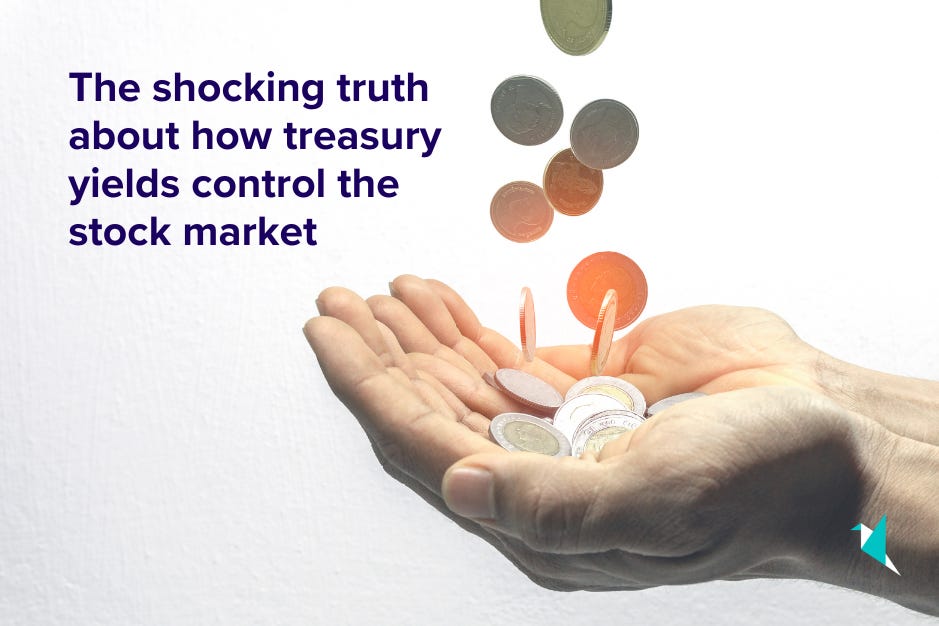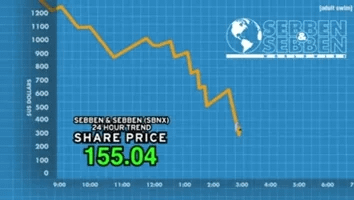The shocking truth about how treasury yields control the stock market
Ever wondered why financial analysts keep talking about Treasury yields? These seemingly boring numbers can have a big impact on the stock market and your investments. Treasury yields are one of the most important indicators in finance, influencing everything from corporate borrowing costs to investor sentiment. Let’s break down what Treasury yields are, why they matter, and how they influence stock market sentiment in a way that’s easy to understand.
🔔 Don’t miss out!
Add winvestacrisps@substack.com to your email list so our updates never land in spam.
What are treasury yields? 🤔
Treasury yields are the interest rates the U.S. government pays investors for lending it money by buying Treasury bonds. Think of it like this: if you loan money to a friend, you’d expect them to pay you back with some extra money as interest. Treasury yields work the same way—investors lend money to the government and earn interest in return.
How treasury yields work
Bond prices and yields move opposite: When bond prices go up, yields go down, and vice versa. It’s like a seesaw! If demand for bonds increases (often during times of uncertainty), their prices rise, and their yields fall. Conversely, when demand decreases, bond prices drop, and yields rise.
Short-term vs. long-term yields: Short-term yields (like 2-year bonds) reflect immediate economic conditions, while long-term yields (like 10-year or 30-year bonds) show expectations for the future.
For example, a 10-year Treasury bond yield reflects what investors expect from the economy over the next decade. If they expect strong growth and inflation, yields will rise; if they foresee slower growth or a recession, yields will fall.
Why do investors care about treasury yields? 💡
Treasury yields aren’t just numbers—they’re signals about the economy and the stock market. Here’s why investors pay close attention to them:
Economic health indicator
Rising yields often mean investors expect strong economic growth, while falling yields suggest concerns about a slowdown or recession. For instance, if inflation is expected to rise, investors demand higher yields to compensate for the reduced purchasing power of future interest payments.
Stock market impact
Higher Treasury yields can make bonds more attractive than stocks because they offer safer returns. This shift can lead investors to move money out of stocks and into bonds, causing stock market declines.
Corporate borrowing costs
Companies borrow money to grow their businesses by issuing corporate bonds or taking loans. Higher Treasury yields increase borrowing costs for companies because corporate bond rates are often tied to Treasury rates. This can hurt profits and slow down business expansion.
How treasury yields influence stock market sentiment 🎮
Treasury yields directly impact stock market sentiment through several channels:
1. Competing investment options
When Treasury yields rise, bonds become more attractive compared to stocks because they offer safer returns with less risk. This can cause investors to sell stocks and buy bonds instead, leading to stock market declines.
2. Valuing stocks
Higher yields increase the "discount rate" used to calculate the value of future earnings from stocks. Growth stocks—like tech companies—are particularly sensitive because their valuations depend heavily on future earnings.
For example:
A tech company promising big profits 10 years from now looks less attractive when higher bond yields offer solid returns today.
Value stocks (like banks or utilities) with steady cash flows tend to hold up better during periods of rising yields.
3. Sector rotation
Certain sectors perform better when Treasury yields rise:
Banks and financials benefit because they earn more from lending at higher rates.
Utilities and consumer staples, which are considered safer investments, may lose appeal as bond alternatives become more attractive.
What’s happening now? April 2025 update 🚀
As of April 2025, the 10-year Treasury yield has surged to 4.28%, its highest level in years! This has caused ripples across the stock market:
Growth stocks (like tech companies) are struggling because higher yields make their future earnings less valuable.
Value stocks (like banks and energy companies) are holding up better because they benefit from rising rates or have stable cash flows.
This rise in Treasury yields has been driven by several factors:
Inflation concerns: Investors fear that inflation may persist longer than expected due to global supply chain disruptions and high consumer spending.
Federal reserve policy: Although the Fed has started cutting short-term interest rates to stimulate growth, long-term rates like the 10-year yield remain elevated due to uncertainty about inflation.
Global market dynamics: International investors are selling U.S. Treasuries due to concerns about geopolitical risks and currency fluctuations.
Lessons from history: How yield changes have shaped markets 📜
Looking at past events can help us understand how Treasury yield changes impact the stock market:
Example 1: The taper tantrum (2013)
When the Federal Reserve announced it would reduce bond-buying (known as tapering), Treasury yields spiked sharply, causing temporary stock market declines before recovering.
Example 2: COVID crash (2020)
During the pandemic, falling Treasury yields initially signaled fear but later supported stock market recovery as central banks intervened with stimulus measures.
These examples show that while rising or falling yields can create short-term volatility in markets, long-term trends depend on broader economic factors like growth and inflation.
How can you navigate rising yields as an investor? 🗺️
Here are some strategies to help you manage your investments when Treasury yields are rising:
1. Diversify your portfolio
Spread your investments across different asset classes like stocks, bonds, and commodities to reduce risk from yield changes.
2. Focus on value stocks
Consider investing in sectors like financials and utilities that tend to perform better when yields rise.
3. Add bonds to your portfolio
Higher Treasury yields mean bonds offer better returns, so adding them to your portfolio can provide stability during volatile times in the stock market.
4. Stay long-term focused
Remember that short-term yield changes don’t define long-term investment success—stick to your financial goals and avoid reacting emotionally to market swings.
Common mistakes investors make during yield changes ⚠
Even seasoned investors can make mistakes during periods of rising or falling Treasury yields. Here are some pitfalls to avoid:
Overreacting: Don’t sell your stocks just because yields rise; consider how they fit into your long-term strategy instead.
Ignoring diversification: Focusing only on one asset class (like stocks) increases risk during yield changes.
Timing the market: Trying to predict when yields will rise or fall is extremely difficult—even for experts.
Overlooking inflation risk: Rising inflation can erode real returns on fixed-income investments like bonds if not accounted for properly.
The global impact of rising yields 🌍
Treasury yield changes don’t just affect U.S.-based investments—they have global implications:
Foreign investors often buy U.S. Treasuries as safe-haven assets during uncertain times.
Rising U.S. yields can cause capital outflows from emerging markets as investors seek higher returns in American bonds.
Currency fluctuations often follow yield changes; higher U.S. yields can strengthen the dollar against other currencies.
The bottom line 🏁
Treasury yields might seem complicated at first glance, but they’re crucial for understanding stock market sentiment and making smart investment decisions:
Rising yields often signal economic strength but can pressure certain stocks.
Falling yields may indicate economic concerns but also boost growth stocks.
By staying diversified, focusing on sectors that perform well in different yield environments, and keeping a long-term perspective, you can navigate these shifts with confidence.
Remember—investing is a marathon, not a sprint! Stay informed but don’t let short-term yield changes derail your long-term goals.
Poll 📊
🚀 Join 60,000+ investors—become a paying subscriber or download the Winvesta app and fund your account to get insights like this for free!
Disclaimer: This article is for informational purposes only and does not constitute investment advice. Always conduct your own research and consider seeking professional financial advice before making any investment decisions.







